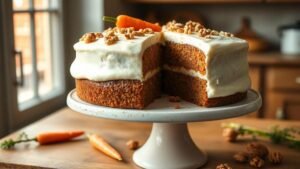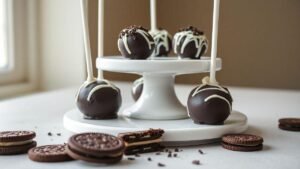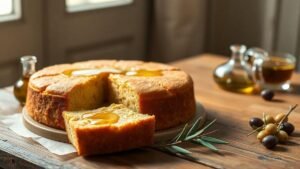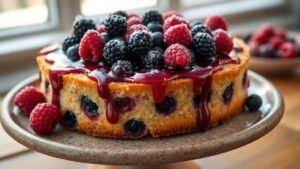How to Make a Simple Glaze for Any Cake: Quick, Sweet, and Versatile
I get wanting a pretty cake without the heavy mess. I share a simple glaze that is light, shiny, and super easy to make. Below I explain what a glaze is, why I choose it over thick frosting, a basic vanilla glaze recipe, flavor ideas, how to apply it, cakes that pair well, and my top pro tips. For a thicker glaze use less liquid. For a thinner glaze add a little more. Try it once and you might never go back to heavy frosting — many cakes that don’t need frosting are perfectly finished with just a glossy glaze.
- A glaze is a thin, pourable icing that makes cakes shiny and light
- It’s lighter than heavy frosting and quick to make
- Basic glaze = powdered sugar a little milk, water, or citrus
- Use less liquid for thicker glaze and more for thinner glaze
- Easy to flavor and pours over many cakes for a polished finish
What Is a Glaze?
A glaze is a thin, pourable icing that sets smooth and glossy — like a light coat of paint for a cake. It can be sweet, tangy, or chocolatey, and it sticks to the cake while keeping texture and layers visible.
| What a glaze is | Key traits |
|---|---|
| Texture | Thin, pourable, smooth |
| Finish | Shiny, lightly set |
| Flavor | Can be sweet, tangy, or rich |
| Use | Quick dress-up for cakes, muffins, loaves |
Why Use Glaze Instead of Frosting?
I pick glaze when I want simple elegance. Frosting can be heavy; a glaze keeps a cake light and takes minutes to make.
| When I pick glaze | Why I pick it |
|---|---|
| Quick dessert | Takes minutes |
| Light mouthfeel | Won’t overpower cake |
| Show cake texture | Keeps crumb visible |
| Less sweet finish | Good for very sweet cakes |
Basic Vanilla Glaze Recipe
This recipe is simple and forgiving — perfect for any beginner.
Ingredients
| Ingredient | Amount | Notes |
|---|---|---|
| Powdered sugar | 1 cup | Sift for smooth glaze |
| Milk or cream | 2–3 tbsp | Use less for thicker glaze |
| Vanilla extract | 1/2 tsp | Or vanilla bean paste |
| Salt | Pinch | Brightens flavor |
Instructions
- Sift powdered sugar into a bowl.
- Add 2 tbsp milk and vanilla.
- Whisk until smooth.
- Add 1 tsp more milk if too thick.
- Pour over a cooled cake.
Tip: Test with a spoonful — the glaze should slowly smooth out, not run like a waterfall.
Flavor Variations
Swap or add small amounts to change the mood.
| Flavor | Swap or add | Notes |
|---|---|---|
| Citrus | Replace 1 tbsp milk with lemon or orange juice | Bright and tangy; pair with fresh fruit or learn how to use fruit as a natural cake topping |
| Chocolate | Add 2 tbsp cocoa powder 1 tbsp milk | For a richer, ganache-like finish try a ganache-style chocolate topping |
| Coffee | Replace milk with cooled strong coffee | Great on chocolate cake |
| Maple | Swap vanilla for 1 tbsp maple syrup | Warm and cozy |
| Spiced | Add 1/2 tsp cinnamon or cardamom | Nice on apple or pumpkin cake |
How to Apply Glaze to a Cake
Think of glazing like drizzling a ribbon — go slow and start with less.
Equipment
| Tool | Why I use it |
|---|---|
| Wire rack | So glaze drips off cleanly |
| Baking sheet | To catch drips |
| Offset spatula | Smooth edges if needed |
| Spoon or ladle | For controlled pouring |
If you want to finish the look without fancy tools, check simple techniques to decorate without piping bags.
Step-by-step
- Cool the cake completely — warm cake melts glaze.
- Place cake on a wire rack over a tray to catch drips.
- Pour glaze in the center and let it flow outward.
- Use a spatula to nudge glaze to edges for full coverage.
- Let set 10–30 minutes until it forms a thin shell.
A little anecdote: I once glazed a bundt in the rain — the glaze held up like a champ. It’s like wrapping the cake in a shiny raincoat.
Cakes That Pair Well with Glaze
| Cake type | Why glaze works |
|---|---|
| Pound cake | Adds shine and extra sweetness |
| Sponge cake | Keeps it light and pretty |
| Bundt cake | Pools in crevices for drama |
| Lemon cake | Extra tang with citrus glaze; also use fruit carefully by following tips on adding fruit without making it soggy |
| Carrot cake | Lighter than thick cream cheese; see ideas for cakes that don’t need frosting |
Pro Tips
- Sift powdered sugar to avoid lumps.
- Cool the cake completely before glazing — if your cake turned out dry or weird, check common fixes at what to do when your cake is too dry.
- Start with less liquid — you can always thin later.
- Chill briefly after glazing to help it set faster.
- Add extracts sparingly — a little goes a long way.
- Use powdered sugar for the smoothest texture.
- For other common issues and quick repairs, see cake baking blunders and how to fix ’em and specific advice on fixing a cake that sinks in the middle.
Light, Sweet, and So Easy
Glazing is the fastest way to make a cake shine. It’s forgiving, quick, and gives a professional finish with minimal fuss. Try it once and you’ll see how simple and lovely it is.
Leave a comment
| Field | Required |
|---|---|
| Comment | yes |
| Name | yes |
| E‑mail | yes |
| Website | optional |
| Save my data in this browser for next time | checkbox |
Your email address will not be published. Required fields are marked.
Last Posts
- I Swear Yogurt Saved My Dry Cake
- I Tried a Fluffy Butterless Chocolate Cake
- I Tried Baking Without Sugar or Flour
- I Baked Moist Cake Without Eggs
Conclusion
A glaze is your best friend — a thin, pourable, light, and shiny coat that finishes a cake in minutes and looks like you fussed for hours. The formula is forgiving: powdered sugar plus a little milk, water, or citrus. Use less liquid for a thicker glaze and more for a thinner one. Test with a spoonful: it should slowly smooth out.
When you apply it, cool the cake, set it on a wire rack, pour from the center, and let it set. Little tricks matter — sift for lump-free gloss, chill briefly to speed setting, and add extracts sparingly.
Try it once and it sticks — like wrapping your cake in a shiny raincoat. It’s quick, forgiving, and lovely. For more no-fuss ideas and unfrosted recipes, explore how to make a cake that doesn’t need frosting or browse other delicious cakes that don’t need frosting.
Frequently Asked Questions
Q: What is a simple cake glaze?
A: A thin, pourable icing that gives a shiny, light coat — less heavy than frosting.
Q: How do I make a basic vanilla glaze?
A: Mix powdered sugar with a little milk or water, stir until smooth, add vanilla extract, and adjust liquid for the desired consistency.
Q: How do I change the glaze thickness?
A: Use less liquid for thicker glaze; add a bit more liquid for thinner glaze. Mix slowly and test the drip.
Q: How do I apply glaze to a cake?
A: Place the cake on a wire rack over a tray, pour in the center and let it spread, and gently nudge drips with a spatula if needed.
Q: What cakes work best with glaze?
A: Simple cakes like pound, loaf, or sponge, as well as citrus, vanilla, and chocolate cakes — use glaze when you want a light, polished finish.






